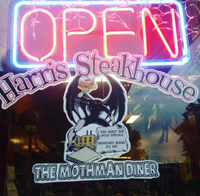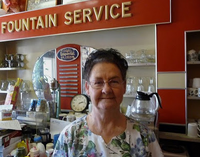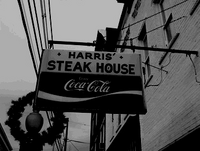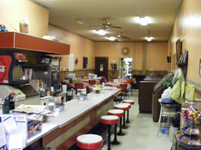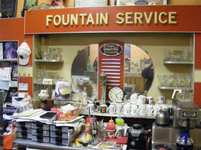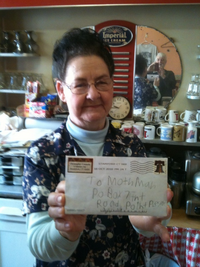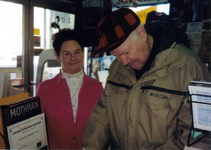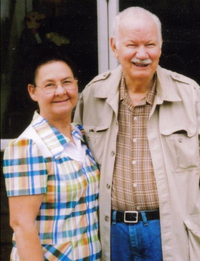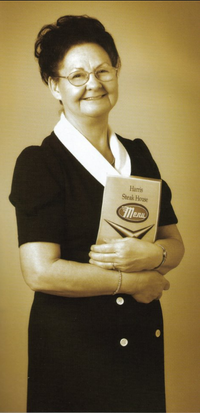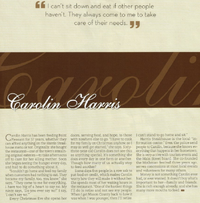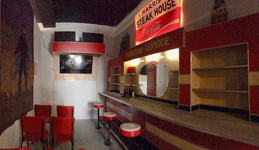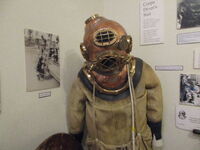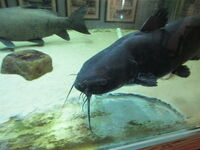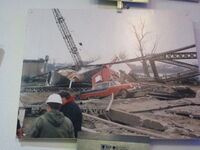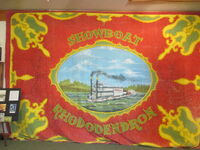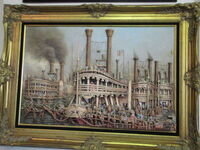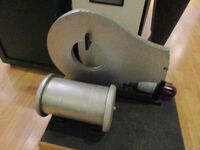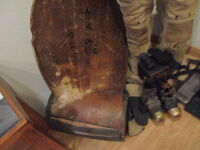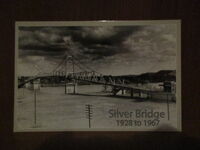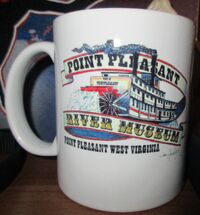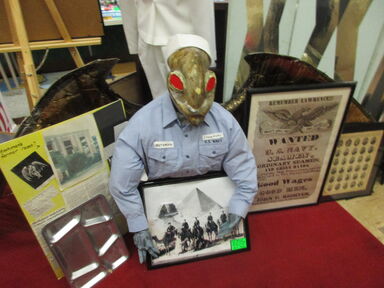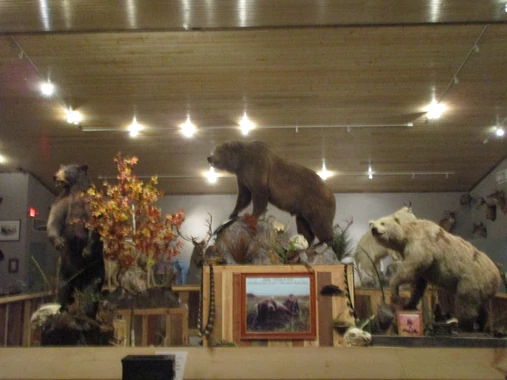"He (The Mothman) is part of our history." - Carolin Harris
Harris Steakhouse AKA The Mothman Diner
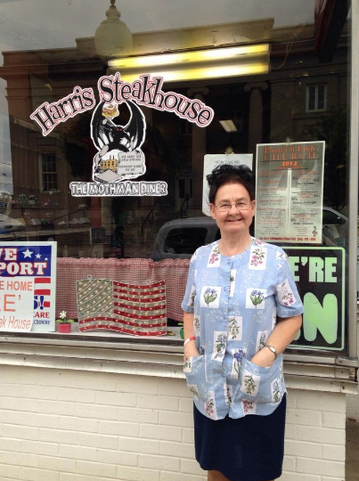
Harris Steakhouse opened on Main Street, Downtown Point Pleasant in 1969 under the ownership of Carolin Harris.
The diner served breakfast, lunch, and dinner to visitors from all over the world and colloquially became known as The Mothman Diner.
The diner set in the "The Mothman Prophecies" movie in 2002 was actually modeled after the Harris Steak House, complete with decor and atmosphere.
The Harris Steak House was located on the same street as the Mothman Museum and Mothman Statue. It received most business during the annual Mothman Festival which Carolin Harris helped start and organize for many years.
Carolin Harris passed away at the age of 74 on Monday, December 26th 2016. She ran the Harris Steakhouse for 48 years. She was a loving person and an active part of the community.
In 2017, an exhibit was added to the Mothman Museum in dedication. It featured the soda fountain counter and chairs from her restaurant which were donated by her family. A plaque was added to the town of Point Pleasant in 2018 which read the following:
"Carolin Harris [1942-2016] was the owner and proprietor of Harris STEAK HOUSE which later became known as the "MOTHMAN DINER." She was like a mother to all, always smiling when she greeted her patrons. The highlight for many was when she took time from her busy day to tell stories about the town of Point Pleasant and the legend of the Mothman. She opened Harris Steak House in 1969, two years after the collapse of the Silver Bridge in which she lost her young son Timmy and his father. Despite the tragic events, her kindness, hospitality, hard work and dedication never faltered. Carolin was instrumental in the development of Point Pleasant and will be forever in the hearts of the residents and many friends who were blessed to know her."
Source(s): https://web.archive.org/web/20120506034401/http://www.mothmanfestival.com/harris.htm http://mydailyregister.com/top-stories/11916/point-loses-main-street-icon-carolin- harris-a-co-founder-of-the-mothman-festival-dies-at-74
The River Museum
The River Museum is located on Main Street in Point Pleasant. The museum has many displays, models, items, photos, and video demonstrations about commercial enterprise and life on the Ohio and Kanawha Rivers.
The museum highlights topics such as boat construction, the great flood, stern-wheel steamers, river disasters and the local river industry's contribution to World War II. It also offers a boating simulator, aquarium and a research library.
The upstairs includes a miniature recreation of The Silver Bridge along with historical photos of the collapse and a video presentation on the subject.
Mothman:
The River Museum is located on the same street as the Mothman Museum and Mothman Statue. Its also been affected by increased business during the Mothman Festivals. The River Museum's gift shop has sold many Mothman themed items such as shirts, mugs, pins, postcards, books, DVDs and figurines.
One interesting item that found its home at The River Museum is a taxidermy snowy owl that was killed in the area and made local headlines along with Mothman back in 1966. Along with the owl being on display is a photo and detailed description.
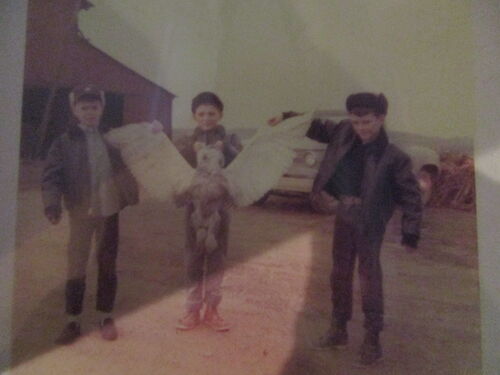
Snowy Owl Picture This picture was taken on 12-22-1966 and is the owl described in Jeff Wamsley's book, Mothman, behind the red eyes. The owl had a wing spread of 5 ft. and was 2 ft. tall. The owl was shot by Ace Henry on his farm at Gallipolis Ferry, WV. The boys holding the owl are Rocky sturgeon, Barry Henry and Kim Henry.
History
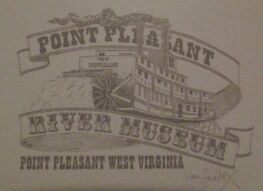
The building which houses the Point Pleasant River Museum has had a connection to the river since at least 1854 when it was established as a mercantile by Robert Mitchell. It has also served as a grocery store to accommodate local residents as well as river traffic via the dock just a few yards away at the end of Main Street. The last owner who used the location as a mercantile was the H. G. Nease Company. Many residents to this day know the Museum building as "The Old Nease Building."
In the 1940's, a local company bought the property and used the structure as storage space. In 1990, the company Hartley, Hartley & Hartley, Inc., donated the building to the City of Point Pleasant for the purpose of creating a River Museum. After many years of hard work, by numerous volunteers, the Point Pleasant River Museum opened its doors to the public on May 1st 2003.
Source(s): http://pprivermuseum.com/ "Giant Owl Killed On Area Farm" Newspaper, 1966 "Not Mason Mothman, Is It An Owl?" Newspaper, 1966
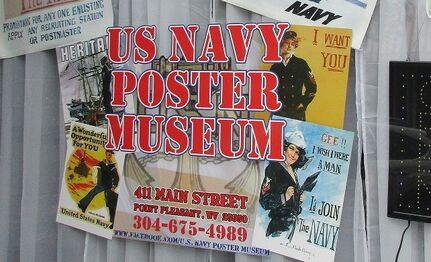
The world’s only U.S. Navy Poster Museum is located on Main Street in Point Pleasant, WV. It opened in September 2014 as a part of the historic Lowe Hotel.
The museum has an extensive collection of Navy Recruiting Posters spanning the last 100 years, featuring the artists JW Burbank, Matt Murphey, McClelland Barclay and many more, as well as a collection of Patriotic Pinups, and a Ship's Store with all kinds of Navy souvenirs including, t-shirts, posters, postcards, pins, patches, hats, key-chains, etc.
Mothman - The Stowaway:
Before the building became the Navy Poster Museum it was used as the first location of The Mothman Museum which was later moved across the street to a place closer to The Mothman statue.
In the move however, the Mothman museum left behind an interesting artifact, a board of information on the local legend and a Mothman mannequin. The Navy Poster Museum owners made use of this leftover Mothman piece by dressing him in a Navy uniform and labeling him in ship terms as a "Stowaway".
Source(s): https://gotowv.com/company/us-navy-poster-museum/ http://www.roadsideamerica.com/tip/45234
Village Pizza (Formerly Tiny's Diner)
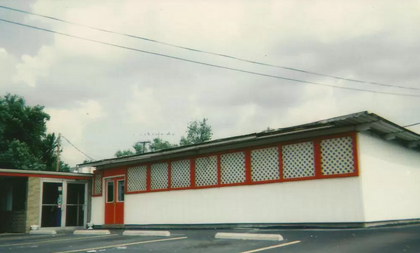
Village Pizza (Formerly Tiny's Diner) is a restaurant in Point Pleasant. Not only do they sell Mothman themed pizza but the place has ties to many Mothman sightings. Its Located on 3004 Jackson Ave in Point Pleasant, WV 25550.
On the night of November 15th 1966, the Scarberry and Mallettes stopped at Tiny's Diner after their famous Mothman sightings as they were trying to figure out what to do next. That's when they decided to contact the police and tell them what they had seen.
Mothman Witness, Connie Carpenter worked at Tiny's Diner. Connie had her sighting on November 27th 1966. She also happened to be the niece of local reporter Mary Hyre.
On Wednesday January 11th 1967, Mrs. Mabel Daniel, Linda Scarberry's mother, had her own Mothman sighting over Route 62, near Tiny's drive-in restaurant, at 5:00 PM. She said "It circled over Tiny's and then flew off."
The Lowe Hotel
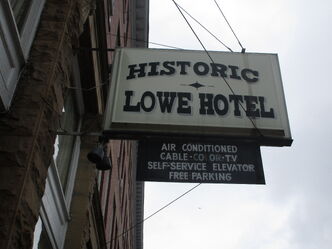
The Lowe Hotel is located in the heart of the Point Pleasant Historic District at the corner of Fourth and Main Streets. Its grand structure was built in 1901 and originally named the Spencer Hotel in honor of J.S. Spencer. Then operated by two brothers, Homer and Griff Smith. The hotel was purchased by the Lowe family in 1929 after the stock market crash and renamed the Lowe Hotel. The hotel is now owned by Ruth and Rush Finley, who purchased the Lowe in 1990. A visit to the Lowe gives a step back in time with today's conveniences.
Ruth and Rush have been continually upgrading the building and adding their personal touch to the business. The friendly atmosphere and hospitality create a very pleasant and restful experience for the traveler.
The Historic Lowe Hotel features unique rooms, each with their own character and style. It includes single or double-bed rooms, family suites, jacuzzi suites and two-room suites.
The sign on the entrance of the large stone building reads "Historic Lowe Hotel" and then below that "Air Conditioned, Cable Color TV, Self-Service Elevator, Free Parking".
The Lowe gets many visitors in September during the yearly Mothman Festival which began in 2002. John Keel, writer of the Mothman Prophecies, stayed in the Lowe hotel in 2003 when he attended the 2nd Annual Mothman Festival.
Source(s): http://www.thelowehotel.com/ http://web.archive.org/web/20070302170008/http://www.thelowehotel.com:80/rooms/rooms.html http://web.archive.org/web/20070302232800/http://www.thelowehotel.com:80/facilities/ facilities.html
WV Farm Museum
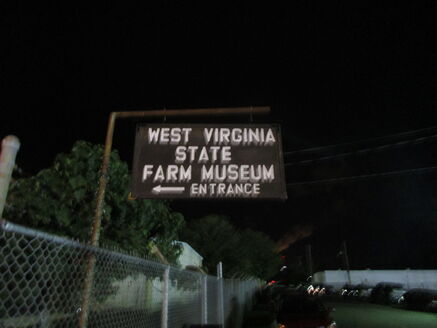
The West Virginia State Farm Museum is located on Route 62 four miles north of Point Pleasant WV. Its a replica of an early rural community. Buildings of historical value have been moved and rebuilt on the grounds.
The Farm Museum has a trail which leads to The TNT Area. During the Mothman Festivals, they use this for The Haunted Hayride Tours. They use a tractor to pull a wagon of hay along the path into the TNT area. Along the way there's a flying Mothman replica that zips over head and other Mothman related scares to frighten people.
The Farm Museum was started in 1976 by Walden Roush, a retired educator. At the time it consisted of only one building and a few farm implements, today the 50-acre site showcases 31 reconstructed buildings, including four original log structures that were moved and rebuilt.
There's an operational 19th century blacksmith shop, country store, veterinary office, barbershop, a post office, turn-of-the-century doctor's office, herb garden, carpenter shop, and a newspaper building with printing presses from 1895. A log church recognized as the first Lutheran church west of the Allegheny Mountains is used for services.
The State Farm Museum has large farm equipment, both horse-drawn and tractor-drawn, such as tractors, thrashers, and plows. There is a Corliss steam engine. There are numerous household items, including appliances and other furnishings.
Greene Building:
The Greene building houses the main artifact collection. Thousands of artifacts are on display showing a way of farm life in this area by our ancestors for over a hundred years.
This large metal building, 60' X 120' X 14' high, was the first building to be erected in the Farm Museum Complex. It was sponsored by the Mason County Commission, and was dedicated May 14, 1976. A large collection of antique farm machinery and farm related implements are displayed in this building.
Christopher Bauer Collection:
The museum is dedicated to Christopher H. Bauer, a native of Mason County, Point Pleasant High graduate, local businessman (barber shop), and avid outdoorsman. This building and Chris's collections are his legacy for all to enjoy.
The museum contains a large collection of mounted and prominently displayed hunting trophies in the main hall. Another display room contains an extensive collection of firearms, knives and other hunting accessories.
The Morgan Museum - Taxidermy:
Part of the Farm Museum is the Morgan Museum, a curiosities collection begun in Putnam County in 1905 by Sidney Morgan of Winfield and later moved to the State Farm Museum, includes a collection of taxidermy stuffed birds and animals, including a two-headed calf, a golden eagle, and a Belgian draft horse.
The farm includes a two-acre pond and acres of crops which are planted and harvested using 19th-century equipment and methods. A stage and picnic shelter accommodate public events.
The Morgan Museum now houses the mounted body of General. General was the third largest horse that ever lived. He stood 19 1/2 hands high and had a certified weight of 2850 pounds.
Schools from West Virginia, Ohio, and Kentucky visit the museum for their study of Appalachian culture. Funded by the West Virginia Department of Agriculture and a small annual grant from the Mason County Commission, the West Virginia State Farm Museum is a nonprofit organization.
The information from some of Mr. Morgan's relatives states that Mr. Sidney Morgan was to go with Teddy Roosevelt (as his taxidermist) on a safari to Africa. For some reason or other (which has been lost to posterity), he did not get to go, and, of course, he was very disappointed. While talking to his brother, Mr. Morgan decided that they should go on their own safari, so they built a small sternwheel paddleboat called the Shirley. During Mr. Morgan's lifetime he made five trips all the way to the Gulf of Mexico, collecting birds and animals along the rivers. He also made trips up and down several other rivers, including the Arkansas and the Missouri.
He financed his trips by taking along sportsmen from the Charleston area who paid him for the trip.
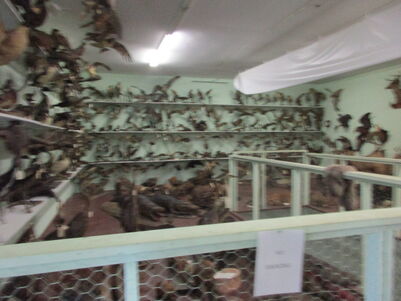
The first bird Mr. Sidney Morgan mounted was a loon, and it is still housed in the museum. It is in the north end of the building, mounted on a green slab. Everything in the Morgan Museum is very old. The work in the museum covers an extensive period of time.
Mr. Morgan was an artist when it came to mounting animals and birds. He made every effort to pose his animals and birds naturally. A good example of his creativity in taxidermy is the red fox located on the top shelf display at the museum. This fox had apparently killed a grouse; so Mr. Morgan not only mounted the grouse, but he also put feathers in the mouth of the fox to make it appear more realistic. Just over from this display is another fox that had killed a duck. This fox is mounted as if running away with the duck slung over its back. As the story goes, Mr. Morgan killed the fox as it was running away from a pond. He then copied its natural pose.
You can see many other examples of his creativity if you look around the museum. For example, there is a raccoon that is mounted on an old hollow tree. Mr. Morgan's step-grandson was with him the night that the raccoon was killed. The tree was cut down, and the slab was added to the exhibit.
The big elk in the back was the last elk killed in West Virginia. Mr. Morgan killed it at Minnehaha Springs, Pocahontas County and mounted it in 1912.
The biggest bird in the museum is the Golden Eagle and the smallest is the little hummingbird. There is also a two-headed calf, which was born in 1926 on one of the farms near Mr. Morgan's museum. It lived for a number of weeks. But, as the story goes, it got out of the barn one cold winter night and froze to death. The farmer found it the next morning just outside the barn. He then gave it to Mr. Morgan to be mounted.
There is also a display of some unusual steel traps. The large trap is hand-made. The other is a Newcome trap, which is said to be one of the largest bear traps ever made. The box traps that are on display were used to trap live game, such as rabbits, opossums, etc. Years ago, most boys had a box trap or two. They would use them to catch rabbits for food.
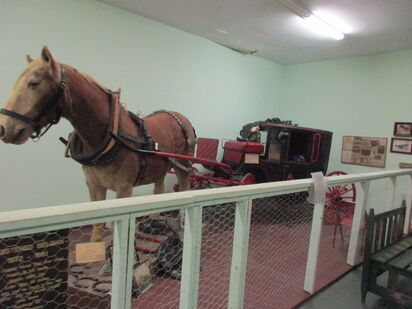
Mr. John E. Greene and his associates of Milton, WV donated the Morgan Museum to the Farm Museum. The Mason County Commission paid the sum of nine thousand dollars to move the four buildings to the Farm Museum complex. Volunteers helped with the moving and were responsible for putting the porches back onto the buildings and for leveling them on their foundations.
The Morgan Museum was started in 1905 just above Winfield on land that is now occupied by the John Amos Power Plant. Mr. Morgan's father owned approximately 1500 acres of choice bottom land where the John Amos Plant is now located. When Morgan's father died, the land was left to Sidney and to his mother, Mrs. Morgan. Sidney Morgan had no interest in farming. His main interests were hunting and taxidermy. Whenever Mrs. Morgan or Sid needed money, they would sell off some of their 1500-acre farm. When the John Amos Power Plant moved in (in 1963) and took over quite a few acres in that area, Mr. Morgan only had four acres left of the original 1500.
The power plant took over the land on which the museum was situated, and the museum was sold at auction. Mr. John E. Greene of Milton, WV bought the Morgan Museum and moved it to Milton near the Blinko Glass Plant. He added three other buildings to the complex, a Country Store, a Country Kitchen and a Blacksmith Shop. After operating these for two or three years as a tourist attraction, Mr. Greene decided to give the four buildings to the Farm Museum.
The propeller on display is from the Airship Shenandoah. The Shenandoah crashed near Ava, Ohio, in 1925, taking the lives of 14 members of its crew.
The Summer Family House:
Historically, the Summers family was prominent in West Virginia politics. George Summers had an illustrious public career. He was elected to the Virginia Legislature in 1830 and to Congress in 1841.
The Summers Log house, part of a farmstead along the Kanawha River near Winfield, West Virginia, is a multi-part structure with architectural evidence indicating a construction date during the first quarter of the 19th century. The physical evidence is consistent with oral history, which gives the building's date as 1812.
The house was moved to the Farm Museum from its original site on a farm known as Walnut Grove near Winfield in Putnam County. The farm was first secured by the family of Judge George William Summers, a prominent Kanawha County resident who was widely known in Virginia, West Virginia and national political arenas.
Not only was he the first prosecuting attorney of Putnam County, he was also a member of the General Assembly of Virginia and also served two terms in the House of Representatives in the United States Congress. He was a strong pro-Union man.
Of interest here is the fact that President Lincoln asked Judge Summers to be his running mate when Lincoln ran for president for a second term. According to family tradition, Summers rejected the offer due to his wife's (Amacetta Laidley Summers) illness.
The Summers house was moved to the Museum on November 23, 1980. Appalachian Power Company, in the process of building the John Amos Power plant, had purchased the farm property of Walnut Grove.
Fred Summers was reputed to be the last family member to occupy the house. It had become the property of his niece, Miss Lucy Quarrier. Through the generosity and interest of Miss Quarrier, the Summers log house was offered to the Museum. Well known in the Art world, Lucy is said to have been one of the founders of the Arts and Crafts Fair at Cedar Lakes near Ripley.
The Log House:
The Log House is a multi-part structure that utilizes two important types of construction in the form of log and plank modules, both of which require expert workmanship. In the original construction, logs were used in the section on the right side of the main entrance while planks were used in the left section. Roush explained that these planks had deteriorated. So it was necessary to use logs also in the left section during the restoration. Planks, however, were used in the back section off the kitchen and dining room.
A large entrance hallway between the two sections included a stairway to the second floor of the one-and-a-half story house. However, the stairway faces the rear of the house so that it would not take up so much room. Two windows are on each front section with three gable-roofed dormer windows extending from the slope of the roof.
Roush stated that it was difficult during the restoration to find weather boarding to match the original. He credited Leon Thompson of the Carolina Lumber Company for finding this material for the Museum. Fireplaces were built in all the rooms, including the upstairs bedrooms. The original mantels were moved with the structure.
Numerous interesting articles of furniture may be seen throughout the house. In the left front room stands an ancient baby crib, mounted on rockers and having a high framework for a canopy used to cover the crib. It was donated to the Museum by John Musgrave.
Also in this room are two other articles of interest. One is what appears to be a High Board but in reality contains a folding bed. Standing in this room is an easel supporting a Shadow Box. This glassed-in box contains a flat surface on which a colorful arrangement of handmade flowers are placed.
Another item that will attract attention is in the kitchen adjoining this room. It is an ancient Home Comfort kitchen range. It was donated by John Scott of Athens, WV. There is another unusual item near the doorway, but we will leave it to the tour guide to explain that one.
The Log House was to have been moved to Charleston, WV, where a full city block had been set aside for it. It was felt that the house would possibly be credited by the National Register of Historic places. This did not develop, and the Farm Museum is the richer for it.
Newspaper Office:
The Point Pleasant Register, then a weekly paper, was housed in a small framed building, when editor George W. Trippett began printing the paper on March 6, 1882. He published the paper for more than 40 years. The masthead, listing Trippett as the editor and proprietor, indicated that the Daily Register was started in 1895.
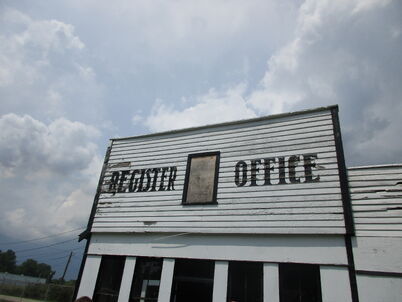
When plans developed for constructing a replica of this newspaper building in the middle 1970's, Oral Eads completed a set of plans for the museum that duplicated the 20-foot by 32-foot structure. All material for the Register Office, which is 20' X 32', were purchased by The Point Pleasant Register. The Good Sam Travel Club, headed by Nelson Ring, who served as supervisor, contributed greatly to this project.
Some of the type and fonts came from L.W. Getty's business. The Register donated a Linotype Machine that is on display in the building as well as some composing tables that held drawers of different size type. The Linotype Machine was one of three that were located on the third floor of the Register building, situated at the time on Fifth Street in Point Pleasant. In the newspaper office you can see various types of printing presses.
Doctor's Office:
Dr. Milton J. Lilly, Sr. was a native of Mercer County in West Virginia and a 1904 graduate of Maryland Medical College in Baltimore. His first practice was as a company doctor for the Pocahontas Coal Company in McDowell County, WV.
Not long after marrying a young school teacher from Roanoke, VA, Dr. Lilly, his wife and infant daughter moved to Upland in Mason County to take over the practice of Dr. James Rowsey.
Dr. Lilly established his practice and home in Mason County raising seven children and living there until his death in 1967
Carpenter Shop:
The Carpenter shop was donated by John E. Greene of Milton, Lafe Chapin of Huntington and Judge Russell Dunbar of Morgantown. It was moved intact from Milton by the Mason County Commission.
The shop displays a large collection of antique carpentry tools. Some of these unique tools include a spring pole wood lathe, a shaving horse, a large wooden punch, two timber morticing drills, 200 year old wooden vices, an all wood morticing machine, and a variety of hand tools ( saws, levels, planes, hand augers, axes, etc.).
Source(s): http://www.wvfarmmuseum.org/, https://www.wvencyclopedia.org/articles/565
Other Noteworthy/Reportedly Haunted WV locations:
- Trans-Allegheny Lunatic Asylum aka Former Weston Hospital In Weston WV (Lewis County)
- Former West Virginia State Penitentiary In Moundsville WV (Marshal County)
- Lake Shawnee, West Virginia (Mercer County)
- The Grave Creek Mound in Moundsville WV (Marshal County)
- The Criel Mound in South Charleston WV (Kanawha County)
